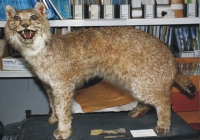Big cat discovery

The Canadian lynx
25 April 2013
The rediscovery of a mystery animal in a museum’s underground storeroom proves that a non-native ‘big cat’ prowled the countryside at the turn of the last century.
Max Blake a PhD student at the Institute of Biological, Environmental, and Rural Sciences (IBERS) at Aberystwyth University rediscovered the specimen among hundreds of thousands of specimens at Bristol Museum and Art Gallery.
Max was part of a multi-disciplinary team of scientists from Aberystwyth, Southampton, Bristol and Durham Universities who analysed the animal’s skeleton and mounted skin.
The specimen was found to be a Canadian lynx – a carnivorous predator more than twice the size of a domestic cat.
The research, published in the academic journal Historical Biology establishes the animal as the earliest example of an alien big cat at large in the UK countryside.
The research team say this provides further evidence for debunking a popular hypothesis that wild cats entered the UK countryside following the introduction of the 1976 Wild Animals Act. The Act was introduced to deal with an increasing fashion for exotic – and potentially dangerous – pets.
The academics believe such feral British big cats as they are known, may have lived in the wild much earlier, through escapes and even deliberate release. There is no evidence that such animals have been able to breed in the wild.
The study of the Canadian lynx, details records unearthed at the museum which showed the animal had originally been mislabelled by Edwardian curators in 1903 as a Eurasian lynx – a close relative of the Canadian lynx.
The records also showed that the lynx was shot by a landowner in the Devon countryside in the early 1900s, after it killed two dogs.
Max Blake, IBERS scientist explains, "Though there are other specimens of exotic cats which have been found in various places in the UK , this lynx is the only one to significantly pre-date the 1976 Dangerous Wild Animals Act.
“Papers and press releases are published regularly describing the discovery of an undescribed species in a museum storeroom, but here it just so happens that this discovery of a previously unrecognised specimen has a significant impact on a fascinating British 'mystery."
The researchers point out in their paper that Eurasian lynxes existed in the wild in the UK many hundreds of years ago, but had almost certainly become extinct by the 7th century. Laboratory analysis of the Bristol specimen’s bones and teeth established it had been kept in captivity long enough to develop severe tooth loss and plaque before it either escaped or was deliberately released into the wild.
Ancient DNA analysis of hair from the lynx proved inconclusive, possibly due to chemicals applied to the pelt during taxidermy.
Julie Finch, head of Bristol’s Museums, Galleries & Archives, said: "Bristol Museum, Galleries and Archives were pleased to be a part of this ground-breaking research, which not only highlights the importance of our science collections, it establishes the pedigree of our 100-year old Lynx and adds to our knowledge and understanding of big cats in the UK.“
The lynx is now on public display at the museum.
AU12813



